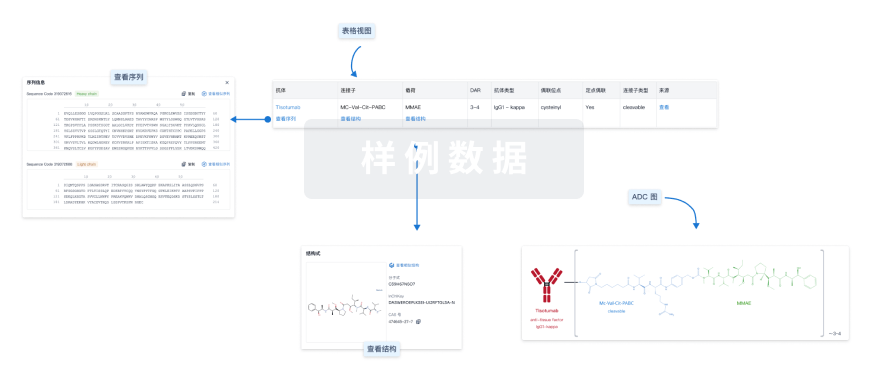预约演示
更新于:2025-11-15
[68]Ga-HA-DOTATATE
更新于:2025-11-15
概要
基本信息
药物类型 多肽偶联核素、诊断用放射药物 |
别名- |
靶点 |
作用方式 调节剂 |
作用机制 SSTR调节剂(生长抑素受体调节剂) |
治疗领域 |
在研适应症 |
非在研适应症- |
原研机构- |
权益机构- |
最高研发阶段临床2期 |
首次获批日期- |
最高研发阶段(中国)- |
特殊审评- |
登录后查看时间轴
结构/序列
使用我们的ADC技术数据为新药研发加速。
登录
或

Sequence Code 19721

当前序列信息引自: *****
关联
3
项与 [68]Ga-HA-DOTATATE 相关的临床试验NCT04888481
68Ga-HA-DOTATATE Imaging of Suspected Somatostatin Receptor Positive Tumors
Somatostatin receptor (SSR) imaging is a critical component of clinical care for many patients being investigated for or with confirmed SSR positive tumors. In the past, 111In-octreotide imaging has been used for this purpose but it has been recently supplanted globally by SSR positron emission tomography (PET) imaging due to better image quality and higher diagnostic accuracy.
This study will assess the safety and diagnostic effectiveness of 68Ga-HA-DOTATATE produced a the Edmonton Radiopharmaceutical Centre (ERC).
This study will assess the safety and diagnostic effectiveness of 68Ga-HA-DOTATATE produced a the Edmonton Radiopharmaceutical Centre (ERC).
开始日期2022-02-15 |
申办/合作机构 |
NCT03145857
A Phase I/II Study of Gallium-68 HA-DOTATATE ([68]Ga-HA-DOTATATE) in Patients With Known or Suspected Somatostatin Receptor Positive Tumours
A [68]Ga-HA-DOTATATE PET/CT or PET/MRI scan is a nuclear medicine test used to create pictures of the whole body that will show where somatostatin receptors are found, including on tumours. Somatostatin receptors are found on most neuroendocrine tumours (NETs), and some other types of tumours. Currently at the Cross Cancer Institute, most patients with suspected somatostatin positive tumours (e.g. NETs) have an In-111 Octreotide (Octreoscan™) scan. A scientific study has shown that a scan with a similar product ([68]Ga-DOTATATE) is more accurate than an Octreoscan™. This study will look at [68]Ga-HA-DOTATATE, a product virtually identical to [68]Ga-DOTATATE.
The purpose of this study is to: 1) demonstrate the safety of [68]Ga-HA-DOTATATE; and 2) confirm that [68]Ga-HA-DOTATATE PET/CT or PET/MRI is effective at diagnosing somatostatin positive tumours.
The purpose of this study is to: 1) demonstrate the safety of [68]Ga-HA-DOTATATE; and 2) confirm that [68]Ga-HA-DOTATATE PET/CT or PET/MRI is effective at diagnosing somatostatin positive tumours.
开始日期2020-03-05 |
申办/合作机构 |
CTRI/2019/04/018409
Performance of 68Ga-DOTATATE,131I â??MIBG and18Fâ??FDG PET in localisation of PPGLâ?? a single centre experience
开始日期2019-06-03 |
申办/合作机构- |
100 项与 [68]Ga-HA-DOTATATE 相关的临床结果
登录后查看更多信息
100 项与 [68]Ga-HA-DOTATATE 相关的转化医学
登录后查看更多信息
100 项与 [68]Ga-HA-DOTATATE 相关的专利(医药)
登录后查看更多信息
8
项与 [68]Ga-HA-DOTATATE 相关的文献(医药)2023-01-01·Frontiers in medicine
Non-invasive estimation of split renal function from routine 68Ga-SSR-PET/CT scans.
Article
作者: Castaneda-Vega, Salvador ; Dittmann, Helmut ; Weissinger, Matthias ; Seyfried, Kyra Celine ; la Fougère, Christian ; Seith, Ferdinand ; Nikolaou, Konstantin ; von Beschwitz, Sebastian ; Ursprung, Stephan ; Vogel, Jonas ; Ghibes, Patrick
Objective:
Patients with impaired kidney function are at elevated risk for nephrotoxicity and hematotoxicity from peptide receptor radionuclide therapy (PPRT) for advanced neuroendocrine tumors. Somatostatin receptor (SSR)-PET/CT imaging is the method of choice to identify sufficient SSR expression as a prerequisite for PRRT. Therefore, our study aimed to explore whether split renal function could be evaluated using imaging data from routine SSR-PET/CT prior to PRRT.
Methods:
In total, 25 consecutive patients who underwent SSR-PET/CT (Siemens Biograph mCT®) before PRRT between June 2019 and December 2020 were enrolled in this retrospective study. PET acquisition in the caudocranial direction started at 20 ± 0.5 min after an i.v. injection of 173 ± 20 MBq [68Ga]Ga-ha DOTATATE, and the kidneys were scanned at 32 ± 0.5 min p.i. The renal parenchyma was segmented semi-automatically using an SUV-based isocontour (SUV between 5 and 15). Multiple parameters including SUVmean of renal parenchyma and blood pool, as well as parenchyma volume, were extracted, and accumulation index (ACI: renal parenchyma volume/SUVmean) and total kidney accumulation (TKA: SUVmean x renal parenchyma volume) were calculated. All data were correlated with the reference standard tubular extraction rate (TER-MAG) from [99mTc]Tc-MAG3 scintigraphy and glomerular filtration rate (GFRCDK - EPI).
Results:
SUVmean of the parenchymal tracer retention showed a negative correlation with TERMAG (r: -0.519, p < 0.001) and GFRCDK - EPI (r: -0.555, p < 0.001) at 32 min p.i. The herein-introduced ACI revealed a significant correlation (p < 0.05) with the total tubular function (r: 0.482), glomerular renal function (r: 0.461), split renal function (r: 0.916), and absolute single-sided renal function (r: 0.549). The mean difference between the split renal function determined by renal scintigraphy and ACI was 1.8 ± 4.2 % points.
Conclusion:
This pilot study indicates that static [68Ga]Ga-ha DOTATATE PET-scans at 32 min p.i. may be used to estimate both split renal function and absolute renal function using the herein proposed "Accumulation Index" (ACI).
2021-09-01·Clinical nuclear medicine3区 · 医学
Discordant Uptake Between Diagnostic 68Ga-HA-DOTATATE PET/CT and Posttherapy 177Lu-HA-DOTATATE SPECT/CT in Patients With Neuroendocrine Tumors
3区 · 医学
Article
作者: Versleijen, Michelle W J ; Huizing, Daphne M V ; Stokkel, Marcel P M ; Aalbersberg, Else A ; van der Hiel, Bernies
Abstract:
Patients with unresectable or metastasized neuroendocrine tumors are assumed eligible for PRRT (peptide receptor radionuclide therapy) with 177Lu-HA-DOTATATE if tumor uptake on somatostatin receptor imaging is higher than normal liver tissue. In our clinic, 2 patients presented with sufficient uptake of 68Ga-HA-DOTATATE in most metastases but with limited uptake in liver lesions. Posttherapy 177Lu imaging, however, showed good uptake in all neuroendocrine tumor lesions, including all liver metastases. Therefore, the presence of liver metastases in which the uptake of 68Ga-HA-DOTATATE is not or only slightly higher than in surrounding normal liver tissue should not be an absolute contraindication for PRRT.
2015-12-01·EJNMMI research3区 · 医学
Twins in spirit - episode I: comparative preclinical evaluation of [68Ga]DOTATATE and [68Ga]HA-DOTATATE
3区 · 医学
ArticleOA
作者: Wester, Hans-Jürgen ; Schottelius, Margret ; Willibald, Marina ; Hoffmann, Frauke ; Schwaiger, Markus ; Šimeček, Jakub
BACKGROUND:
Recently, an intra-patient comparison demonstrated that the somatostatin (sst) ligand [(68)Ga]HA-DOTATATE ([(68)Ga]DOTA-3-iodo-Tyr(3)-octreotate) provides PET images comparable to or superior to those obtained with [(68)Ga]DOTATATE. To provide a comprehensive basis for nevertheless observed slight differences in tracer biodistribution and dosimetry, the characteristics of [(68)Ga]HA-DOTATATE were investigated in a detailed preclinical study.
METHODS:
Affinities of (nat)Ga-HA-DOTATATE and (nat)Ga-DOTATATE to sst1-5 were determined using membrane preparations and [(125)I]SST-28 as radioligand. Internalization into AR42J cells was studied in dual-tracer studies with [(125)I]TOC as internal reference. Biodistribution was investigated using AR42J tumor-bearing CD1 mice, and specificity of tracer uptake was confirmed in competition studies by coinjection of 0.8 mg TOC/kg.
RESULTS:
Sst2 affinities (IC50) of [(nat)Ga]HA-DOTATATE (1.4 ± 0.8 nM, logP: -3.16) and [(nat)Ga]DOTATATE (1.2 ± 0.6 nM, logP: -3.69) were nearly identical. Both compounds displayed IC50 > 1 μM for sst1,3,4, while sst5 affinity was markedly increased for (nat)Ga-HA-DOTATATE (102 ± 65 nM vs >1 μM for (nat)Ga-DOTATATE). [(nat)Lu]HA-DOTATATE and [(nat)Lu]DOTATATE showed slightly lower, identical sst2 affinities (2.0 ± 1.6 and 2.0 ± 0.8 nM, respectively) and sst3 affinities of 93 ± 1 and 162 ± 16 nM. Internalization of [(68)Ga]HA-DOTATATE was tenfold higher than that of [(125)I]TOC but only sixfold higher for [(68)Ga]DOTATATE and [(177)Lu]HA-DOTATATE. While [(68)Ga]HA-DOTATATE and [(68)Ga]DOTATATE had shown similar target- and non-target uptake in patients, biodistribution studies in mice at 1 h post injection (n = 5) revealed slightly increased non-specific uptake of [(68)Ga]HA-DOTATATE in the blood, liver, and intestines (0.7 ± 0.3, 1.0 ± 0.2, and 4.0 ± 0.7 %iD/g vs 0.3 ± 0.1, 0.5 ± 0.1, and 2.7 ± 0.8 %iD/g for [(68)Ga]DOTATATE). However, sst-mediated accumulation of [(68)Ga]HA-DOTATATE in the pancreas, adrenals, and tumor was significantly enhanced (36.6 ± 4.3, 10.8 ± 3.2, and 33.6 ± 10.9 %iD/g vs 26.1 ± 5.0, 5.1 ± 1.4, and 24.1 ± 4.9 %iD/g, respectively). Consequently, tumor/background ratios for [(68)Ga]HA-DOTATATE in the AR42J model are comparable or slightly increased compared to [(68)Ga]DOTATATE.
CONCLUSIONS:
The present preclinical data fully confirm the general biodistribution pattern and excellent in vivo sst-targeting characteristics previously observed for [(68)Ga]HA-DOTATATE in patients. The effect of slightly enhanced lipophilicity on background accumulation and normal organ dose is compensated by the high uptake of [(68)Ga]HA-DOTATATE in tumor. Thus, [(68)Ga]HA-DOTATATE represents a fully adequate, freely available substitute for [(68)Ga]DOTATATE and, given the superb sst-targeting characteristics of [(177)Lu]HA-DOTATATE in vitro, potential applicability for sst-targeted PRRT.
1
项与 [68]Ga-HA-DOTATATE 相关的新闻(医药)2023-10-17
·药智网
据国际罕见病日官网数据显示,全球罕见病患者超过3亿人,约占全球总人口的3.5%至5.9%,严格意义上来讲“罕见病或许并不罕见”,而如此巨大的临床需求之下,全球研发管线中也有超过1/3比例属于了“罕见病新药”研究,令人震惊。近来,时隔五年的《第二批罕见病目录》公布,不仅对国内大量罕见病患家庭来讲是盼望已久的好消息,也令无数罕见病家庭重拾了希望。并且,目录的发布从另一方面来讲也为我国加强罕见病管理、提高罕见病诊疗水平、维护罕见病患者健康权益提供了充分的法律依据,对于未来罕见病诊疗保障事业的推动、促进药物可及、健全患者保障体系具有重要指导意义。细节上,此次发布的《第二批罕见病目录》中共涉及了86个罕见病种,叠加第一批目录下的121种罕见病,两批目录目前已收录了207种罕见病。同时,在第二批罕见病目录中,也有不少重点内容值得提及,即有超过29种罕见病的40+创新药已经在国内获批上市,10+种罕见病新药即将上市,更有超过18种罕见病领域国内尚无一家药企布局。0129种罕见病国内新药已上市首先,针对《第二批罕见病目录》中公布的疾病种类,统计相关疾病的海内外新药获批情况,发现至少有29种罕见病国内目前已有新药上市(不完全统计),其中不仅有肢端肥大症、新生儿肺动脉高压、幼年特发性关节炎等遗传学疾病,更有皮肤T细胞淋巴瘤、骨巨细胞瘤、神经母细胞瘤等高发“罕见肿瘤”疾病。数据来源:药智数据、公开数据整理(手动统计,错误望指正)在全球3亿罕见病患者的巨大市场驱动下,海内外虽不断有罕见病新药成功上市,但整体上仍超过90%的罕见病尚无治疗方法,这也导致“罕见病新药研究”成为了现阶段医药探索和疗法研发的重点领域之一。而事实上,有关资料也显示近年来FDA药物评估与研究中心(CDER)批准的新药中,有超过50%的比例均为罕见病,罕见病适应症研究占据了全球新药临床管线的3成,足见其重大趋势。对比之下,国内获批上市的罕见病新药与其巨大的临床需求仍处于失衡状态,反而任重而道远。不过,好在有关机构对于上述问题非常重视,未来也会有越来越多罕见病新药逐步面市,值得期待。针对获批罕见病新药细节,以神经母细胞瘤为例,据药智数据-全球药物分析系统以及公开消息显示,全球范围内已有超过70种新药涉及了该适应症,初步统计有13款药品海外获批上市,15款药品处于Ⅱ期临床,23款药品处于Ⅰ期临床,还有22款新药处于临床前与临床申请阶段。数据来源:药智数据、公开数据整理(手动统计,错误望指正)而另一款重点罕见病“神经纤维瘤病”也值得一提,其备受期待的硫酸舍美替尼(selumetinib sulfate) 已于2023年5月8日在国内获批用于治疗3岁及3岁以上伴有症状、无法手术的丛状神经纤维瘤的I型神经纤维瘤病儿童患者,改变了一直以来相关病患依靠超适应症用药治疗的局面,开启了I型神经纤维瘤病治疗的新篇章。当然,诸如上述类似的新药案例不止于此,对于罕见病领域而言,临床需求的任何一项满足相比其他疾病领域或许更显弥足珍贵,也更值得庆贺。当然新药上市也并非罕见病治疗终点,在第二批罕见病目录的助力之下,获批罕见病新药也更有希望得到医保等核心政策的加持,进一步加强罕见患者的用药可及性与成本优化。0218种罕见病“境外有药,境内无药”除了上述罕见病目录中的“有药可用”的情况,其实罕见病目录中更多仍是“境外有药,境内无药”的情况,据药智数据显示,不完全统计之下,目录中至少有18种罕见病在国内尚无相关适应症的研究布局,其中不乏梅克尔细胞癌、早衰病、巨细胞动脉炎、神经元蜡样质沉积症等临床新药需求迫切的领域。数据来源:药智数据、公开数据整理(手动统计,错误望指正)对于这部分罕见病而言,海外上市情况多为局部地区(不仅限于美国FDA,也包括欧盟、日本、韩国等),在此基础上,虽然国内领域的罕见病适应症并未获批,但仍可以依靠相关获批药品的超适应症用药来曲线救国。但整体来讲,这部分的临床需求相对迫切,对于国内药企而言,借此次纳入第二批罕见病目录,或许也可以选择在避开愈发同质化愈发严重的常规创新药市场,转而积极拓展罕见病适应症的新药开发。数据来源:药智数据、公开数据整理(手动统计,错误望指正)以巨细胞动脉炎为例,目前全球范围内涉及适应症药品共有10款,其中托西利珠单抗2010年美国获批用于治疗巨细胞动脉炎,司库奇尤单抗、西鲁库单抗、乌帕替尼、萨瑞鲁单抗处于临床Ⅲ期,68Ga-HA-DOTATATE、巴瑞替尼、古塞奇尤单抗、玛弗利木单抗、英夫利西单抗五款创新药处于临床Ⅱ期间,为国内领域尚无任何相关适应症布局,主要依靠以上产品国内其他适应症超适应症用药,对于相关企业,不可谓不是一个大好机会。0310+种罕见病“新药”国内即将上市最后,在罕见病目录中还有更值得一提的,即有超过10款罕见病新药或将在未来短时间内在国内获批上市。数据来源:药智数据、公开数据整理(手动统计,错误望指正)细节上,以慢性炎性脱髓鞘性多发性神经根神经病中的“巴托利单抗”为例,在和铂医药与HanAll签署战略合作协议,获得了HL161(巴托利单抗)在大中华地区的授权之后,目前其药品研发已临近了收获期,慢性炎症性脱髓鞘性多发性神经病(CIDP)也或将成为巴托利单抗继“重症肌无力”适应症申报上市之后,第二个紧跟而上的适应症,目前已经处于了临床Ⅲ期阶段。巴托利单抗适应症进展图片来源:药智数据另一个备受关注的罕见病领域,腱鞘巨细胞瘤(TGCT)作为一种罕见的局部浸润性软组织肿瘤,病理上可分为弥漫性和局限型。根据相关文献报道,超过50%的弥漫性TGCT患者在手术切除后仍会复发,目前国内同样也尚无针对无法手术的腱鞘巨细胞瘤患者的治疗药物上市。而自从首款CSF-1R 抑制剂“盐酸培达替尼”在海外获批治疗腱鞘巨细胞瘤后,其国内也于2020年已进入临床Ⅲ期,但目前,国内领域和誉医药的ABSK021也同样位于了临床Ⅲ期阶段,并且其在治疗晚期腱鞘巨细胞瘤的Ib期数据ORR达到了68%,高于“盐酸培达替尼”,且有1例完全缓解,对比之下似乎优势更大,也更有希望能率先夺下领域内国内首款。ABSK021的适应症进展图片来源:药智数据当然,除了上述例子外,名单中还有针对肾透明细胞肉瘤的贝组替凡、嗜酸性粒细胞性胃肠炎的贝那利珠单抗、Lennox-Gastaut综合征的索替司他、天疱疮的艾加莫德、多发性大动脉炎的乌帕替尼等等,其无一不是国内非常值得期待的罕见病新药,跟有希望在近期就给相关病患带来新的治疗曙光。04罕见肿瘤纳入罕见病目录最后,在针对第二批罕见病目录的具体分析下,可以看出其罕见病新药研发方面,肿瘤新药所占比例较大,如此情况也是在此次目录中首次出现,据统计,第一批罕见病目录中肿瘤领域的纳入比例仅3%左右,而此次目录直接提高至了28%,超过20余种罕见病肿瘤被纳入。此情况下,导致部分肿瘤创新药无意间即涵盖了部分罕见病适应症,也是导致目录中出现大量罕见病新药即将上市的原因之一。对此,行业人士表示了一定程度的担心,毕竟对于肿瘤领域而言,无论是其疗法还是支付保证机制似乎已相对完善,而对于更多遗传性质的罕见疾病疗法的欠缺才应该是罕见病目录最应该考虑的内容。再者,肿瘤+罕见病的政策重叠以及罕见病适应症快速审批下的投机行为或许也会成为未来新的问题所在。不过,无论情况如何,就目前罕见病目录整体而言,罕见病+肿瘤的结合模式始终会是未来绕不开的坎,尝试之下或许更有希望推进产业进步,况且至少就目前罕见病目录中相关创新药的布局情况看,无论是对于病患的用药可及性,还是未来更多药企的研发积极性上,其推动作用都无疑是肯定的。未来,值得期待。来源 | 博药(药智网获取授权转载)撰稿 | 万叶责任编辑 | 八角声明:本文系药智网转载内容,图片、文字版权归原作者所有,转载目的在于传递更多信息,并不代表本平台观点。如涉及作品内容、版权和其它问题,请在本平台留言,我们将在第一时间删除。商务合作 | 王存星 19922864877(同微信) 阅读原文,是昨天最受欢迎的文章哦
上市批准
100 项与 [68]Ga-HA-DOTATATE 相关的药物交易
登录后查看更多信息
研发状态
10 条进展最快的记录, 后查看更多信息
登录
| 适应症 | 最高研发状态 | 国家/地区 | 公司 | 日期 |
|---|---|---|---|---|
| 生长抑素受体阳性神经内分泌肿瘤 | 临床2期 | 加拿大 | 2020-03-05 | |
| 神经内分泌肿瘤 | 临床2期 | 美国 | 2019-01-30 |
登录后查看更多信息
临床结果
临床结果
适应症
分期
评价
查看全部结果
| 研究 | 分期 | 人群特征 | 评价人数 | 分组 | 结果 | 评价 | 发布日期 |
|---|
No Data | |||||||
登录后查看更多信息
转化医学
使用我们的转化医学数据加速您的研究。
登录
或

药物交易
使用我们的药物交易数据加速您的研究。
登录
或

核心专利
使用我们的核心专利数据促进您的研究。
登录
或

临床分析
紧跟全球注册中心的最新临床试验。
登录
或

批准
利用最新的监管批准信息加速您的研究。
登录
或

特殊审评
只需点击几下即可了解关键药物信息。
登录
或

生物医药百科问答
全新生物医药AI Agent 覆盖科研全链路,让突破性发现快人一步
立即开始免费试用!
智慧芽新药情报库是智慧芽专为生命科学人士构建的基于AI的创新药情报平台,助您全方位提升您的研发与决策效率。
立即开始数据试用!
智慧芽新药库数据也通过智慧芽数据服务平台,以API或者数据包形式对外开放,助您更加充分利用智慧芽新药情报信息。
生物序列数据库
生物药研发创新
免费使用
化学结构数据库
小分子化药研发创新
免费使用

